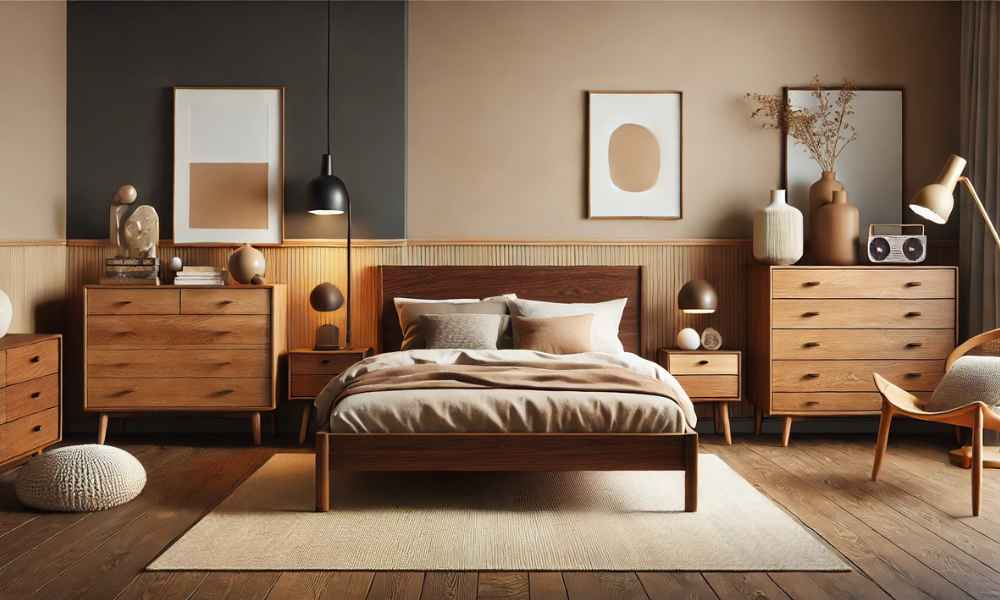Creating a cozy, stylish bedroom isn’t just about choosing the right bedding or paint color—it’s also about how you arrange and pair your furniture. If you’ve ever wondered how to mix and match wood furniture in the bedroom without making it look chaotic, you’re not alone. Many people assume that all their timber pieces need to be the exact same shade or style, but that’s far from the truth. In fact, mixing timber tones can add depth, character, and warmth to your space, giving it a unique, lived-in feel that’s both functional and beautiful.
Understanding Wood Tones
Before diving into the art of mixing, it’s essential to understand the basics of wood tones. Wood comes in a variety of shades, typically categorized as light, medium, or dark. Light woods like pine and ash bring an airy, fresh vibe, while medium tones such as oak or teak offer a balanced, earthy look. Dark woods like walnut and mahogany add richness and sophistication. The key isn’t to match these tones perfectly but to create a harmonious contrast. Additionally, paying attention to timber undertones—whether warm, cool, or neutral—can help ensure your pieces complement rather than clash with each other.
Benefits of Mixing and Matching Wood Furniture
Bother mixing wood tones in the first place? The answer is simple: it adds visual interest and personality to your bedroom. When done thoughtfully, a combination of different timber finishes can make your space feel layered and dynamic, rather than flat and one-dimensional. It allows for more flexibility in decorating, giving you the freedom to incorporate vintage finds, heirloom pieces, or modern designs without worrying about perfect matches. Plus, mixing woods adds warmth and texture, creating an inviting environment that feels curated over time, rather than bought from a single showroom.
Key Principles to Follow

While mixing wood furniture offers creative freedom, a few key principles can help you achieve a balanced, cohesive look. First, consider the 80/20 rule: let one timber tone dominate around 80% of the space, with the other tones playing supporting roles. This prevents the room from feeling too busy. Second, maintain consistency with undertones—pair warm woods with other warm woods, and cool with cool—to create a sense of harmony. Lastly, embrace contrast thoughtfully. For example, pairing a dark walnut bed frame with light oak nightstands can create a striking yet balanced effect, especially when tied together with textiles or decor that bridge the gap between tones.
Choosing a Dominant Wood Tone
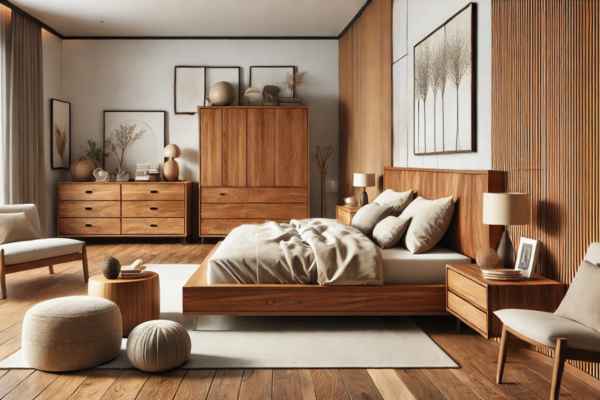
Learning how to mix and match timber furniture in bedroom spaces, the first step is to choose a dominant wood tone. Think of this as the anchor for your design. This primary tone will set the foundation, creating a cohesive look even as you introduce contrasting pieces. Typically, the dominant timber comes from the largest furniture item, like your bed frame, dresser, or wardrobe. Once you’ve chosen your base tone—whether it’s a light oak, rich walnut, or medium-toned teak—you can layer in other wood finishes that either complement or contrast it. Keeping this anchor tone consistent throughout larger elements helps avoid a cluttered or mismatched appearance.
Blending Different Finishes with Ease

Blending different wood finishes doesn’t have to be complicated. In fact, mixing glossy, matte, and distressed finishes can add an interesting dynamic to your bedroom’s decor. The key is balance. For example, if your bed frame has a smooth, polished finish, you might pair it with a nightstand featuring a more rustic, weathered look. This contrast adds character without overwhelming the space. To maintain harmony, keep an eye on the undertones of the timber—warm tones like cherry and mahogany pair well together, while cooler tones like ash and gray-washed oak complement each other seamlessly. Adding rugs, throws, or soft textiles can help blend these finishes, creating a cozy, unified feel.
Using Color to Tie Everything Together

Mixing wood tones, color can act as the magical glue that brings everything together. Neutral walls, bedding, and decor items provide a calming backdrop that allows the different wood shades to shine without competing. Alternatively, you can use accent colors to bridge the gap between contrasting woods. For instance, if you have a dark walnut dresser and a light pine bed frame, incorporating earthy green or deep navy textiles can create a cohesive flow. Even subtle touches like artwork, throw pillows, or lampshades in coordinating hues can tie the entire room together beautifully.
Incorporating Modern and Vintage Wood Pieces
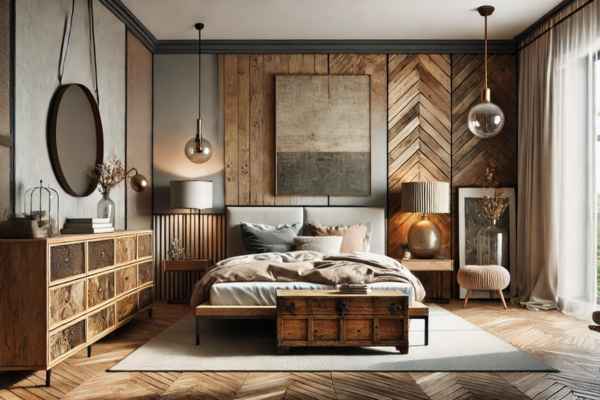
Blending modern and vintage timber furniture adds depth and personality to your bedroom. The trick is to find a common thread—whether it’s the finish, color, or overall design aesthetic. For example, a sleek, minimalist modern bed frame can look stunning when paired with an antique wooden chest at the foot of the bed. The contrast between old and new creates visual interest and tells a story within your space. To make this mix feel intentional, add transitional pieces like contemporary lamps with vintage-inspired bases or modern artwork framed in reclaimed timber. This fusion of styles results in a space that feels both curated and timeless.
Balancing Wood with Other Materials
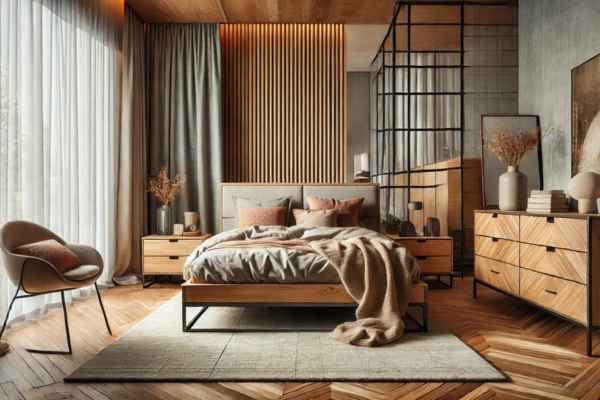
While wood is the star of the show, incorporating other materials helps balance the look and prevent your bedroom from feeling too heavy or monotonous. Consider introducing metal, glass, or upholstered elements to break up the wooden textures. For example, a metal bed frame can pair beautifully with wooden nightstands, while a glass-top dresser adds a modern, airy touch. Fabrics also play a crucial role—plush rugs, linen curtains, or velvet cushions can soften the strong lines of timber furniture and create a cozy, inviting atmosphere. By mixing materials thoughtfully, you’ll achieve a layered, harmonious space where every element complements the next.
Arranging Furniture for a Cohesive Layout
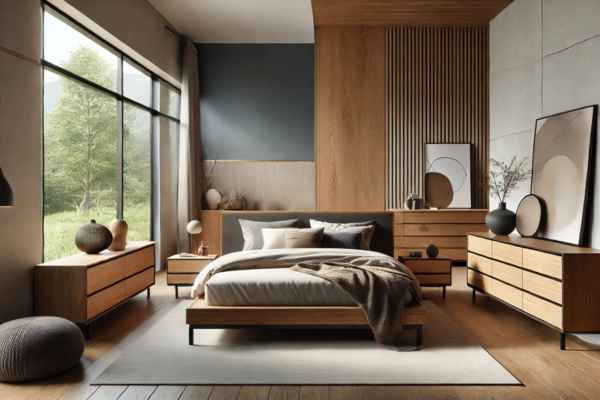
How to mix and match wood furniture in bedroom spaces, the arrangement plays a key role in creating a cohesive look. Start by identifying a focal point—this could be your bed, a large dresser, or even a window with a beautiful view. Arrange your wood furniture around this anchor to create a sense of balance and flow. For example, if your bed is a dark walnut, consider placing lighter-toned nightstands on either side to create contrast while maintaining symmetry. Spacing is also important; avoid crowding similar timber tones together. Instead, distribute different wood finishes evenly throughout the room to maintain visual harmony.
Common Mistakes to Avoid
Mixing wood furniture can be fun, but there are some common mistakes to avoid. One of the biggest pitfalls is trying to match everything perfectly, which can make your space feel flat and uninspired. On the flip side, mixing too many timber tones without a clear strategy can lead to a chaotic, cluttered look. Another mistake is ignoring wood undertones—pairing warm and cool woods without a unifying element can make the room feel disjointed. Finally, neglecting the role of texture and finish can result in a lackluster design. Remember, balance and contrast are your best friends when mixing wood furniture.
Quick Fixes to Improve Mismatched Furniture
Your bedroom feels mismatched, don’t worry—there are simple fixes to create a more cohesive look. One quick trick is to use accessories like rugs, throw pillows, and blankets to bridge the gap between contrasting wood tones. Adding a large area rug, for instance, can visually separate pieces and soften stark contrasts. Another easy fix is to repaint or refinish smaller items, like nightstands or shelves, to better complement your dominant timber tone. Even changing hardware on dressers or adding decorative items with similar finishes can tie the room together without a major overhaul.
Inspiration Gallery
Sometimes, all you need is a little visual inspiration to spark ideas for your own space. Picture a serene bedroom with a white oak bed frame, complemented by dark walnut nightstands and a mid-century modern teak dresser. The mix of tones feels intentional, not random, thanks to neutral bedding and a cozy woven rug that ties everything together. Or imagine a rustic bedroom with reclaimed wood accents, layered with sleek, modern pieces in lighter finishes. These combinations show that mixing wood tones can create dynamic, stylish spaces that reflect your personality and design taste.
Conclusion
Mastering how to mix and match wood furniture in bedroom spaces is all about balance, creativity, and confidence. By choosing a dominant wood tone, blending finishes thoughtfully, and incorporating other materials, you can create a bedroom that feels warm, inviting, and uniquely yours. Don’t be afraid to experiment—sometimes, the most unexpected combinations result in the most stunning designs. Trust your instincts, keep these tips in mind, and soon you’ll have a beautifully curated bedroom that showcases your personal style with ease.
